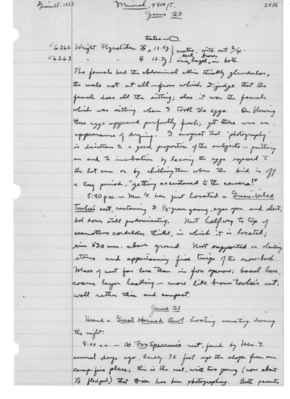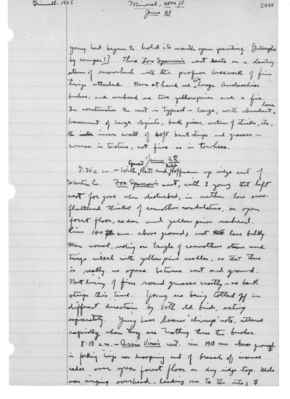Pages
S2 Page 30
Collector: Grinnell-1925 Location: Mineral Date: June 20 Page Number: 2485
whir, an old grouse rose from the ground hardly ten feet from us and made off without cluck or whistle, thru the trees out of sight. We then marched and shortly heard the peeping of chicks, and the two were seen. They had started to run away from us, evidently having not been told to "freeze"! The one youngster caught is much bigger than the ones found on the 17th; the wings are well-feathered.
11:30 a.m. - Spent much time searching the meadow for the object of concern of a pair of Lincoln Sparrow. Finally flushed a bobtailed youngster of this species from the grass; it fell in the water, and rapidly flopped across it into a willow thicket beyond.
3:00 p.m. - Collected a Wright Flycatcher nest and both parents. Found several days ago by Mrs. G, and since the set (2/4) was completed on the 17th, Dixon has been photographing it and the bird; several trials necessary. Rim just 800 mm. above the ground; nest supported by stem (and innovating twiglets), one of an ^open, low clump of chinquapin growing on a southwest-facing gentle slope. No other chinquapin about this clump; other brush ceanothus and amelanchier; firs a few yards away. Nest but slightly sheltered from above by the leaves of scarcely a foot of chinquapin spray. Female sitting closely, and when she flew off close along ground with soft "pit"s, male flew down from fir to a bush 50 feet off.
S2 Page 31
Collector: Grinnell-1925 Location: Mineral, 4800 ft., Date: June 20 Page Number: 2486
6262 Wright Flycatcher (male) ^testes [illustration] 12.5 g 6263 [Wright] [Flycatcher] (female) 12.7 g } mates, with set 2/4. iris ^dark hazel ^brown in both.
The female had the abdominal skin thickly glandular, the male not at all - from which I judge that the female does all the sitting; also it was the female which was sitting when I took the eggs. On blowing these eggs appeared perfectly fresh; yet there was an appearance of drying. I suspect that "photography" is disastrous to a good proportion of the subjects - putting an end to incubation by leaving the eggs exposed to the hot sun or by chilling them when the bird is off a long period, "getting accustomed to the camera!"
5:40 p.m. - Mrs. G. has just located a Green-tailed Towhee's nest, containing 3 1/3-grown young, eyes open and alert, but down still predominating. Nest halfway to top of ceanothus cordulatus thicket, in which it is located; rim 520 mm. above ground. Nest supported on slanting stems and appertaining fine twigs of the snow-bush. Mass of nest far less than in fox sparrow; basal loose, coarse layer lacking - more like brown towhee's nest; wall rather thin and compact.
June 21 Heard a Great Horned Owl hooting something during the night.
8:00 a.m. - At Fox Sparrow's nest, found by Mrs. G. several days ago, hardly 75 feet up the slope from our camp-fire place; this is the nest, with two young (now about 1/3 fledged) that Dixon had been photographing. Both parents
S2 Page 32
Collector: Grinnell-1925 Location: Mineral, 4800 ft. Date: June 21 Page Number: 2487
are exceedingly fearless, probably because they have been accustomed all along to forage about our camp-site. The (male) sings from the ground, from bush-tips, from well up in the pines and fir above - whether a person be at the nest or not. The female is much the more solicitous, and attentive to the nest and young. Right now I am sitting by the nest, my face a little above its level and about 4 feet from it (the rim is 505 mm. above the ground). The female hops all around me, on the ground and thru the bushes. She comes to within a foot of my knee, as close to my shoulder, evidently concerned but not at all alarmed. She has fed the young twice, at 8:12 and 8:14, each time with food-stuffs from within her bill. As she works about me, she is continually picking up very small objects, all the while uttering a faint "seat." She droops the wing-ends, and raises the tail free of the ground; often the tail is turned at an angle sideways, from the axis of the body. The male hops about farther away, 8 - to 10 - foot radius, and utters a much louder, metallic "klink" - then breaks into full song. 8:29 - female just fed young a third time, also swallowed excrement voided by the young. Fed again at 8:31, then inspected nest closely - for excrement, but none was forthcoming. Female has another note, which I at first ascribed to a chipmunk - a low "chuckle", voice-like. Fed again at 8:32 and 8:34, all food being gathered within a radius of ten feet. Young then shaded from the sunshine for half a minute; one
S2 Page 33
Collector: Grinnell-1925 Location: Mineral, 4800 ft. Date: June 21 Page Number: 2488
young had begun to hold its mouth open pouting. [Interrupted by camper!] This Fox Sparrow's nest rests on a slanting stem of snow-bush with the proper lacework of fine twigs attached. Near at hand are two large Amelanchier bushes; and overhead are two yellow pines and a fir. In construction the nest is typical - large, with abundant loose basement of large objects, bark pieces, section of sticks, etc., the inner wall of soft bark strips and grasses course in texture, not fine as in towhees.
June 22 7:34 a.m. - With ^Egmont Rett and ^Ralph Hoffmann up ridge east of Martin Cr. Fox Sparrow's nest, with 3 young that left nest for good when disturbed, in rather low snow flattened thicket of ceanothus cordulatus, on open forest floor, cedar and yellow pines overhead. Rim 140 ft mm. above ground; nest last less bulky than usual, resting on tangle of ceanothus stems and twigs mixed with yellow pine needles, so that there is really no open space between nest and ground. Nest lining of fine round grasses mostly - no bark strips this time. Young are being lolled (?) off in different direction by both old birds, acting separately. Young have hoarse "chirrup" note, uttered rapidly when they are trotting thru the bushes.
8:15 a.m. - Cassin Vireo's nest: rim 1910 mm. above ground in forking twigs near drooping end of branch of incense cedar over open forest floor on dry ridge top. Male was singing overhead, leading me to the site; [female symbol]
S2 Page 34
Collector: Grinnell-1925 Location: Mineral Date: June 22 Page Number: 2489
sitting closely, nearly touched before she flew off. Nest 1750 mm out to south of trunk of cedar, which is a small tree, 8 in. diam., growing beneath sugar pine and white fir. Taken; incubation of eggs ^well begun. (1/4).
8:05 a.m. - Mt. Chickadee's nest, with well-feathered young, in old woodpecker (?) hole in barkless broken-off pine stub 2 ft. in diam.; lower edge of entrance, 1950 mm. above ground. Diam. of entrance 40 mm.; ^38 mm. nest diam.; Both old birds are bringing food to young.
Just followed up a song which puzzled me. The producer would stay ^still, perched 75 to 100 feet up in firs or yellow pines. Sang a sustained, vigorous, dry trill, but dropping toward end. Quietly chipping sparrow like, but this falling at the end made me suspect an orange crowned warbler. The bird, finally seen clearly, was a Chipping Sparrow.
One or more Golden-crowned Kinglets in a clump of young fir. A Solitaire "creaking" in the distance. A Pileated Woodpecker, flying thru the woods, giving its resonant "Kuk" slowly and irregularly in a long series. At least two singing Calaveras Warblers on this dry ridge in vicinity of some smallish black oaks, but singing from all sorts of places, up to 75 feet up in firs and cedars. Tho Ch Calif. Purple Finches in full song nearby.
10:12 a.m. - Solitaire's nest, on level of ground inside a cavity (old burn) in base of ^living sugar pine 2 1/2 feet in diameter. The four young are wholly




